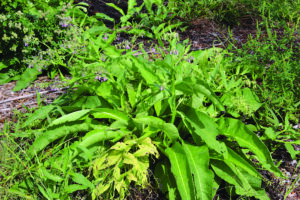
Comfrey is touted as a great natural fertilizer source but some of the plant’s characteristics require management to keep it from getting out of control. (Photo by Sean Clougherty)
Fertilizers comes in numerous forms and in the category of “green manure” — plants whose biomass puts nutrients back into the soil — there’s Comfrey.
Maria Velikonja, a Master Gardener and owner of Carniola Farms in Parsonsburg swears by the plant as a fertility source in permaculture planting.
According the N.C. State Extension, comfrey leaves area an excellent source of nitrogen and contain two to three times more potassium than animal manure.
Velikonja uses the plant either as a nutritious mulch layer around her fruit trees and other plants or steeps leaves in water to make a compost tea that can be applied as a liquid fertilizer.
The foliage also can be an activator to a compost pile, adding nitrogen and heat.
Comfrey, Symphytum officinale L., is highly-adaptable in many environments and can reach heights of 3 to 5 feet tall and produce copious amounts of leaves with thick, hairy stems.
Flowers appear in bell-like clusters in a color range from pink, purple, blue to white. Below ground, comfrey’s taproot is very long making it an effective nutrient scavenger but also difficult to eradicate once established. In addition, any root fragments remaining in the soil will take root and regrow. Comfrey also self-seeds, so it will need some degree of management to keep it in check.
Comfrey has a history as a medicinal herb, but further research has shown it contains a toxic substance known as pyrrolizidine alkaloids that is linked to liver damage. Consequently in 2001, the FDA required that all oral comfrey supplements be removed from the marketplace. The substance also can be absorbed through the skin and thus use of topical ointments containing Comfrey should be limited and under the guidance of medical professionals.
Handling the leaves themselves doesn’t appear to pose much of a threat, although their thick hairy stems may lead you to use gloves.



